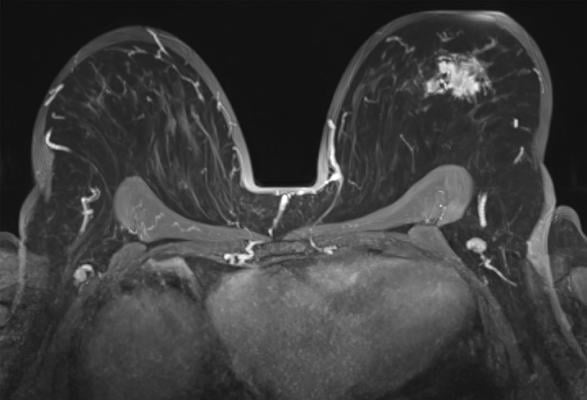
Breast MRI with a tumoral lession in the left breast, axial view. Getty Images
August 30, 2022 — Breast tissue features apparent on MRI are linked with future second breast cancer risk in women with a personal history of breast cancer, according to a study published in Radiology, a journal of the Radiological Society of North America (RSNA).
Breast cancer is the most diagnosed cancer and the leading cause of cancer-related death in women worldwide. While advances in treatment and early detection mean that more women are surviving breast cancer, these women face an increased risk of second breast cancers.
Breast cancer survivors with dense breasts face an even greater risk of a second cancer. Breast tissue is mostly fatty, with areas of fibrous connective tissue and glandular tissue known collectively as fibroglandular tissue. Women with dense breasts have a greater proportion of fibroglandular tissue and less fatty tissue. This can obscure lesions on mammography and is an independent risk factor for breast cancer.
Breast MRI has become the preferred method for imaging women with personal history of breast cancer. Previous studies have shown that breast MRI has a higher cancer detection rate than mammography.
“Postoperative surveillance breast MRI is increasingly being performed according to the American College of Radiology’s annual recommendation for women with dense breasts or those diagnosed with breast cancer before age 50,” said study lead author Su Hyun Lee, M.D., Ph.D., from the Department of Radiology at Seoul National University Hospital in Seoul, Korea.
Dr. Lee and colleagues studied the link between second cancer risk and background parenchymal enhancement (BPE) at surveillance breast MRI. BPE refers to the brightening, or enhancement, of background tissue on MRI after administration of a contrast agent. The degree of BPE can vary between and within women. It is thought to be related to changes in the blood supply and permeability of breast tissue, which is affected by hormonal status. Breast cancer treatment in the form of radiation therapy, chemotherapy or endocrine therapy can also alter the BPE in the treated breast.
BPE on contrast-enhanced breast MRI is a known risk factor for breast cancer. Less is known about the links between BPE at surveillance breast MRI and the risk of second breast cancer.
Of the 2,668 women in the study, 109 developed a second breast cancer at a median follow-up of 5.8 years. Mild, moderate, or marked BPE at surveillance breast MRI was independently associated with an increased risk of future second breast cancer compared to minimal BPE.
“The results suggest that BPE at postoperative surveillance breast MRI may indicate the response to breast cancer treatment and may be a predictor of the modified risk of second breast cancer after treatment in women with a personal history of breast cancer,” Dr. Lee said.
The study findings point to a role for BPE measurements in refining screening pathways for women with prior breast cancer, Dr. Lee said.
“Our study results may help to stratify the risk of second breast cancer in women with a personal history of breast cancer and to establish personalized imaging surveillance strategies in terms of imaging modality and monitoring interval selection,” she said. “For example, women with minimal BPE at surveillance breast MRI may no longer need to undergo contrast-enhanced breast MRI every year if other risk factors are absent.”
Those other risk factors include younger age at diagnosis, the presence of genetic mutations linked to breast cancer and hormone receptor expression in the initial breast cancer.
Areas for future study include the link between BPE changes at screening or preoperative breast MRI and at postoperative surveillance breast MRI and the development of second breast cancer.
In the future, Dr. Lee expects that risk models will use mammography, ultrasound and MRI together. This approach, she said, will lead to more tailored surveillance strategies for women with a history of breast cancer.
For more information: www.rsna.org
Related Breast MRI content:
Contrast-Enhanced In-Phase Dixon Sequence: Impact on Biopsy Clip Detection on Breast MRI
Breast MRI Illuminates Risk of Second Breast Cancer
Contrast-Enhanced Mammography vs. MRI: Neoadjuvant Therapy Response in Breast Cancer
Breast MRI Shows IUDs Have Systemic Effects
VIDEO: Use of Breast MRI Screening in Women With Dense Breasts — Interview with Christiane Kuhl, M.D.
Abbreviated MRI Outperforms 3-D Mammograms at Finding Cancer in Dense Breasts
VIDEO: Explaining Dense Breasts — Interview with Christiane Kuhl, M.D.
VIDEO: Use of Breast MRI Improved Cancer Detection in Dense Breasts in Dutch Study — Interview with Gillian Newstead, M.D.
Technologies to Watch in Breast Imaging
Screening MRI Detects BI-RADS 3 Breast Cancer in High-risk Patients
Rapid Breast MRI Screening Improves Cancer Detection in Dense Breasts


 July 30, 2024
July 30, 2024 








